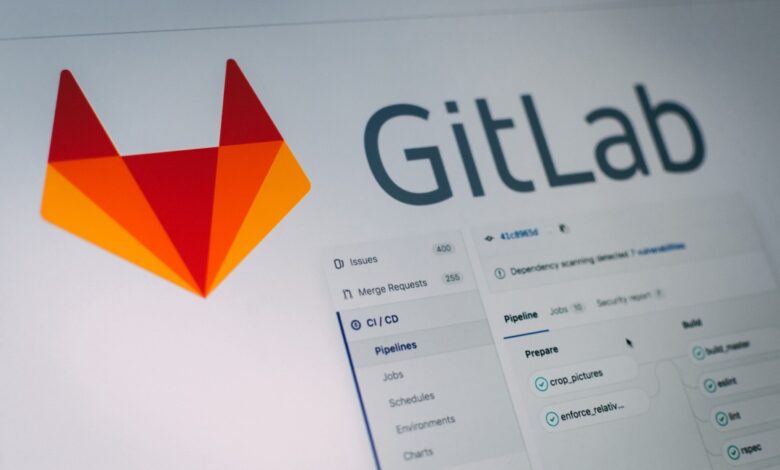Mastering Version Control with GitLab: A Beginner’s Guide to Streamlining Your Scientific Research
Mastering Version Control with GitLab: A Beginner's Guide to Streamlining Your Scientific Research

Welcome to “Mastering Version Control with GitLab: A Beginner’s Guide to Streamlining Your Scientific Research,” where we dive into the world of GitLab and how it can revolutionize the way researchers handle version control. Whether you’re a seasoned scientist or just starting out in the field, this article is your gateway to harnessing the power of GitLab for your research projects.
Version control is indispensable in today’s fast-paced research environment, allowing multiple collaborators to work on the same project seamlessly. And GitLab is the ultimate tool that simplifies this process. With its user-friendly interface and powerful features, GitLab enables researchers to effortlessly track changes, roll back to previous versions, and collaborate effectively.
In this comprehensive guide, we’ll walk you through the basics of GitLab, from setting up your account and creating repositories to branching, merging, and resolving conflicts. We’ll also explore advanced topics like continuous integration and deployment, ensuring your research stays on track and your code is always up to date.
So, whether you’re a biologist, physicist, or any other researcher looking to streamline your scientific research, join us on this journey to master GitLab and take your collaboration to new heights.
Benefits of using version control for scientific research
Version control has become an essential tool for scientific research, providing numerous benefits to researchers. Firstly, version control allows for easy tracking of changes made to a project. With GitLab, every change is recorded, enabling researchers to review and understand the evolution of their work. This feature is especially valuable when working with large teams or when collaborating with remote colleagues.
Secondly, version control facilitates collaboration among researchers. Totallyscience GitLab provides a centralized platform where team members can contribute to a project simultaneously. This eliminates the need for manual merging of changes and reduces the chances of conflicts arising. Additionally, GitLab allows for efficient code review, ensuring that the quality of the research output is maintained.
Another advantage of using version control in scientific research is the ability to roll back to previous versions. Mistakes happen, and sometimes changes need to be undone. GitLab makes it easy to revert to a previous state of a project, providing researchers with a safety net and peace of mind.
In summary, version control with GitLab offers researchers the ability to track changes, collaborate effectively, and easily revert to previous versions. These benefits streamline the research process and enhance productivity, making GitLab an invaluable tool in scientific research.
Overview of GitLab features and functionality
GitLab is a powerful platform that offers a wide range of features to streamline the version control process in scientific research. Let’s explore some of the key features and functionality that make GitLab an indispensable tool for researchers.
One of the standout features of GitLab is its user-friendly interface. The platform is designed to be intuitive and easy to navigate, even for those new to version control. GitLab provides a visually appealing and organized dashboard, making it simple to access repositories, track changes, and collaborate with team members.
GitLab also offers advanced branching and merging capabilities. Branching allows researchers to work on different versions of a project simultaneously, enabling experimentation without affecting the main codebase. Merging, on the other hand, brings these branches together, combining the changes made by different team members into a cohesive whole. GitLab’s merging functionality ensures that conflicts are minimized and collaboration is seamless.
Additionally, GitLab supports continuous integration and deployment, automating the process of building, testing, and deploying project code. This feature is particularly useful in scientific research where reproducibility is crucial. With GitLab’s continuous integration, researchers can ensure that their code is always up to date and functional, saving time and effort in the long run.
These are just a few of the features that make GitLab a robust version control platform for scientific research. In the next section, we will guide you through the process of setting up GitLab for your research project.
Setting up GitLab for your research project
Getting started with totallyscience GitLab for your research project is a straightforward process. Follow these steps to set up your GitLab account and create repositories:
- Create a GitLab account: Visit the GitLab website and sign up for an account. You can choose between a free account or paid options with additional features. Once you’ve created an account, you’ll have access to your personal GitLab profile and dashboard.
- Create a new repository: In GitLab, a repository is a storage space for your project code. To create a new repository, navigate to your dashboard and click on the “New project” button. Give your repository a name and choose its visibility settings. You can opt for a public repository, visible to anyone, or a private repository, accessible only to authorized collaborators.
- Clone the repository: After creating the repository, you’ll need to clone it to your local machine. Cloning creates a local copy of the repository on your computer, allowing you to make changes and contribute to the project. To clone the repository, find the repository’s URL in GitLab and use the Git command
git clone <repository URL>in your terminal.
Once you’ve completed these steps, you’re ready to start using GitLab for your research project. In the next section, we’ll provide an overview of Git and its key concepts to help you understand the underlying principles of version control.
Understanding Git and its key concepts
Git is a distributed version control system that forms the backbone of GitLab. Understanding Git and its key concepts is essential for effectively using GitLab in your research projects. Let’s explore some of the fundamental concepts of Git:
- Commits: In Git, a commit represents a snapshot of your project at a particular point in time. Each commit has a unique identifier and contains all the changes made since the previous commit. Commits serve as milestones in the project’s history and are the building blocks of version control.
- Branches: Branches in Git allow for parallel development. They enable researchers to work on different features or experiments simultaneously, without affecting the main codebase. Branches can be created, switched between, and merged in GitLab, providing flexibility and enabling collaboration.
- Merging: Merging is the process of combining changes from one branch into another. GitLab provides tools to merge branches with ease, automatically resolving conflicts whenever possible. Merging is crucial for bringing together the work of different team members and maintaining a cohesive project.
- Pull requests: Pull requests are a mechanism for proposing changes to a project. They allow team members to review and discuss code before merging it into the main branch. GitLab provides a user-friendly interface for creating and managing pull requests, facilitating efficient code review and collaboration.
These are just a few of the key concepts in Git. Understanding these concepts will help you navigate GitLab and make the most of its features. In the next section, we’ll dive into working with branches and merging changes in GitLab.
Working with branches and merging changes in GitLab
Branching and merging are fundamental to version control with GitLab. Let’s explore how to work with branches and merge changes effectively in GitLab:
- Creating branches: To create a new branch in GitLab, navigate to your project’s repository and click on the “Branches” tab. Here, you can create a new branch by entering a name for the branch and selecting the branch you want to base it on. Once created, you can switch to the new branch and start working on your changes.
- Making changes: Once you’re on a branch, you can make changes to your project’s code. GitLab provides various ways to make changes, including using the web-based editor or cloning the repository to your local machine and making changes there. Regardless of the method, GitLab will track the changes you make.
- Committing changes: After making changes, it’s important to commit them to the branch. In GitLab, commits serve as checkpoints in the project’s history, allowing you to track and review changes over time. To commit changes, provide a meaningful commit message that describes the changes made and click on the commit button.
- Merging changes: Once you’ve made changes on a branch and are ready to merge them into the main branch, you can create a merge request in GitLab. A merge request serves as a proposal to merge changes into the main branch, allowing team members to review the changes and provide feedback. GitLab provides an intuitive interface for creating merge requests and resolving conflicts that may arise.
By following these steps, you can effectively work with branches and merge changes in GitLab. Next, we’ll explore how to collaborate with team members using GitLab.
Collaborating with team members using GitLab
GitLab’s collaboration features make it easy to work with team members on research projects. Let’s explore some of the ways you can collaborate with others using GitLab:
- Access controls: GitLab allows you to control access to your project repositories. You can define who can view, edit, or contribute to your project, ensuring that the right people have the necessary permissions. This is especially useful when working with sensitive research data or when collaborating with external partners.
- Code review: GitLab provides a built-in code review system, allowing team members to review and comment on each other’s code changes. Code review is crucial for maintaining code quality and ensuring that research outputs meet the required standards. GitLab’s code review system streamlines the review process, making it easy to provide feedback and suggestions.
- Issue tracking: GitLab offers an issue tracking system that allows team members to create, assign, and track issues related to a project. Issues can be used to report bugs, suggest new features, or discuss project improvements. GitLab’s issue tracking system enhances collaboration by providing a centralized platform for communication and task management.
- Notifications and activity feeds: GitLab keeps you updated on project activities through notifications and activity feeds. You can customize the types of notifications you receive, ensuring that you stay informed about relevant changes and updates. GitLab’s activity feeds provide a snapshot of recent project activities, allowing you to quickly catch up on important events.
By leveraging these collaboration features, you can enhance teamwork and productivity in your research projects. In the next section, we’ll explore how to integrate GitLab with popular scientific tools and platforms.
Integrating GitLab with popular scientific tools and platforms
GitLab can be seamlessly integrated with popular scientific tools and platforms, enhancing the research workflow. Let’s explore some of the ways you can integrate GitLab with other tools:
- Jupyter Notebooks: Jupyter Notebooks are a popular tool for interactive data analysis and visualization. GitLab allows you to store Jupyter Notebooks in your repositories, enabling version control and collaboration on these essential research documents. With GitLab’s integration, you can easily track changes made to your Jupyter Notebooks and collaborate with team members.
- Continuous integration tools: GitLab provides integration with various continuous integration (CI) tools, such as Jenkins and Travis CI. CI tools automate the process of building, testing, and deploying code, ensuring that your research projects are always up to date and functional. Integrating GitLab with CI tools streamlines the research workflow and improves code quality.
- Data management platforms: Research often involves working with large datasets. GitLab can be integrated with data management platforms like Databricks or Redash, enabling seamless collaboration on data analysis and visualization. By connecting GitLab with these platforms, researchers can ensure that data is easily accessible and up to date.
- Project management tools: GitLab can be integrated with project management tools like Trello or Asana, providing a unified platform for task tracking and progress monitoring. This integration allows researchers to manage their projects efficiently, ensuring that important tasks are not overlooked.
By integrating GitLab with these tools and platforms, you can enhance your research workflow and streamline collaboration. In the next section, we’ll explore best practices for using GitLab in scientific research.
Best practices for using GitLab in scientific research
To make the most of GitLab in your scientific research projects, it’s important to follow some best practices. Here are a few tips to help you leverage GitLab effectively:
- Create meaningful commit messages: When committing changes in GitLab, provide descriptive commit messages that clearly explain the changes made. This makes it easier for team members to understand the purpose of the commit and track changes over time.
- Regularly pull changes: To stay up to date with the latest changes made by team members, regularly pull changes from the main branch into your local branch. This ensures that your code is always synchronized with the project and reduces the chances of conflicts during merging.
- Use branches for experimental work: When working on experimental features or changes, create separate branches to isolate your work. This allows you to iterate and experiment without affecting the main codebase. Once your changes are stable, you can merge them into the main branch.
- Leverage code review: Take advantage of GitLab’s code review system to review and provide feedback on code changes made by team members. Code review helps maintain code quality and ensures that research outputs meet the required standards.
By following these best practices, you can harness the full potential of GitLab in your scientific research projects. In the concluding section, we’ll summarize the key points covered in this guide and provide next steps for mastering version control with GitLab.
Conclusion and next steps for mastering version control with GitLab
In this comprehensive guide, we explored the world of GitLab and its potential for revolutionizing version control in scientific research. We discussed the benefits of using version control, provided an overview of GitLab’s features, and walked you through the process of setting up GitLab for your research project.
We delved into the key concepts of Git and explained how to work with branches and merge changes effectively in GitLab. We also explored the collaboration features of GitLab and discussed how to integrate GitLab with popular scientific tools and platforms.




One Comment